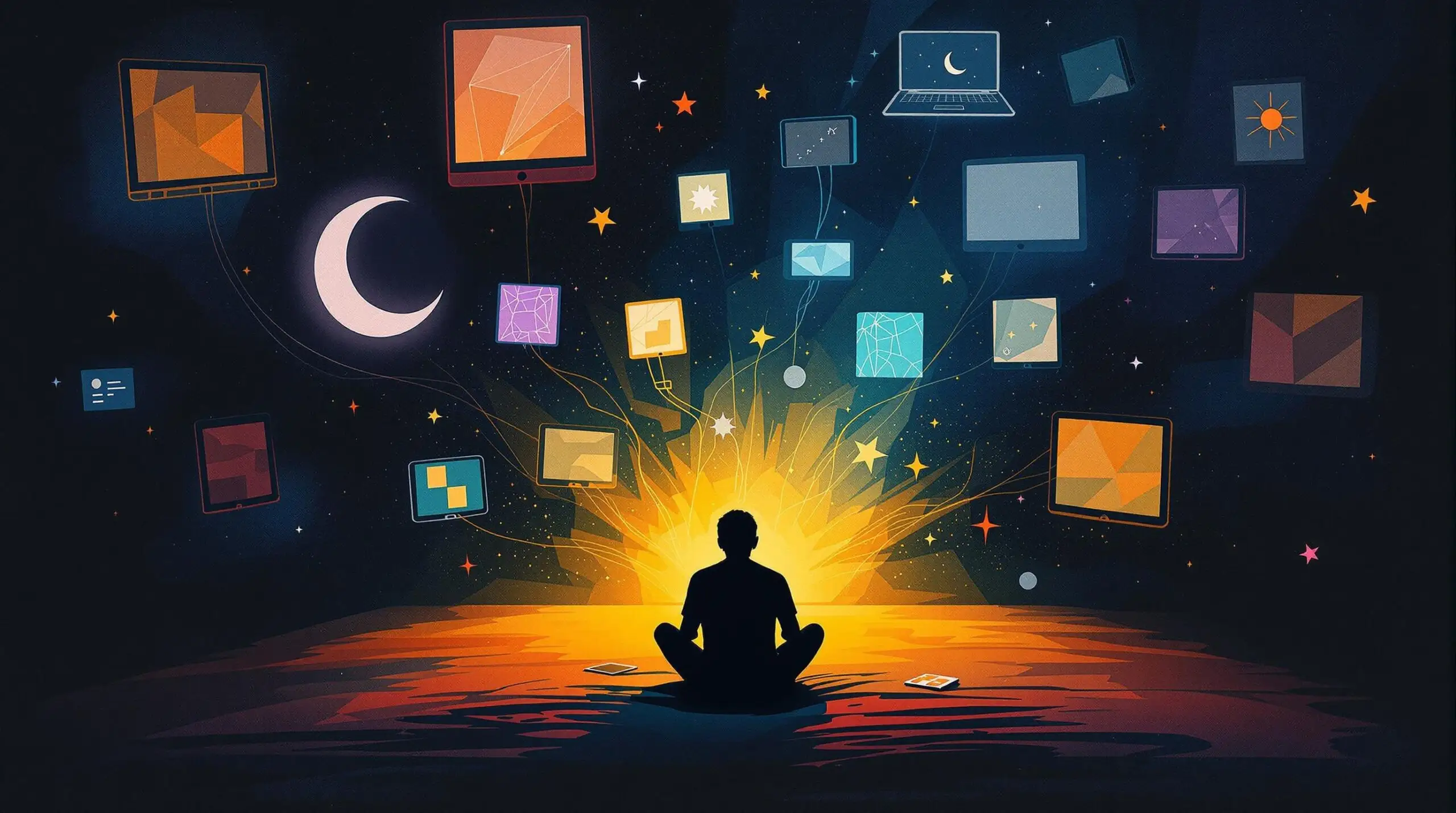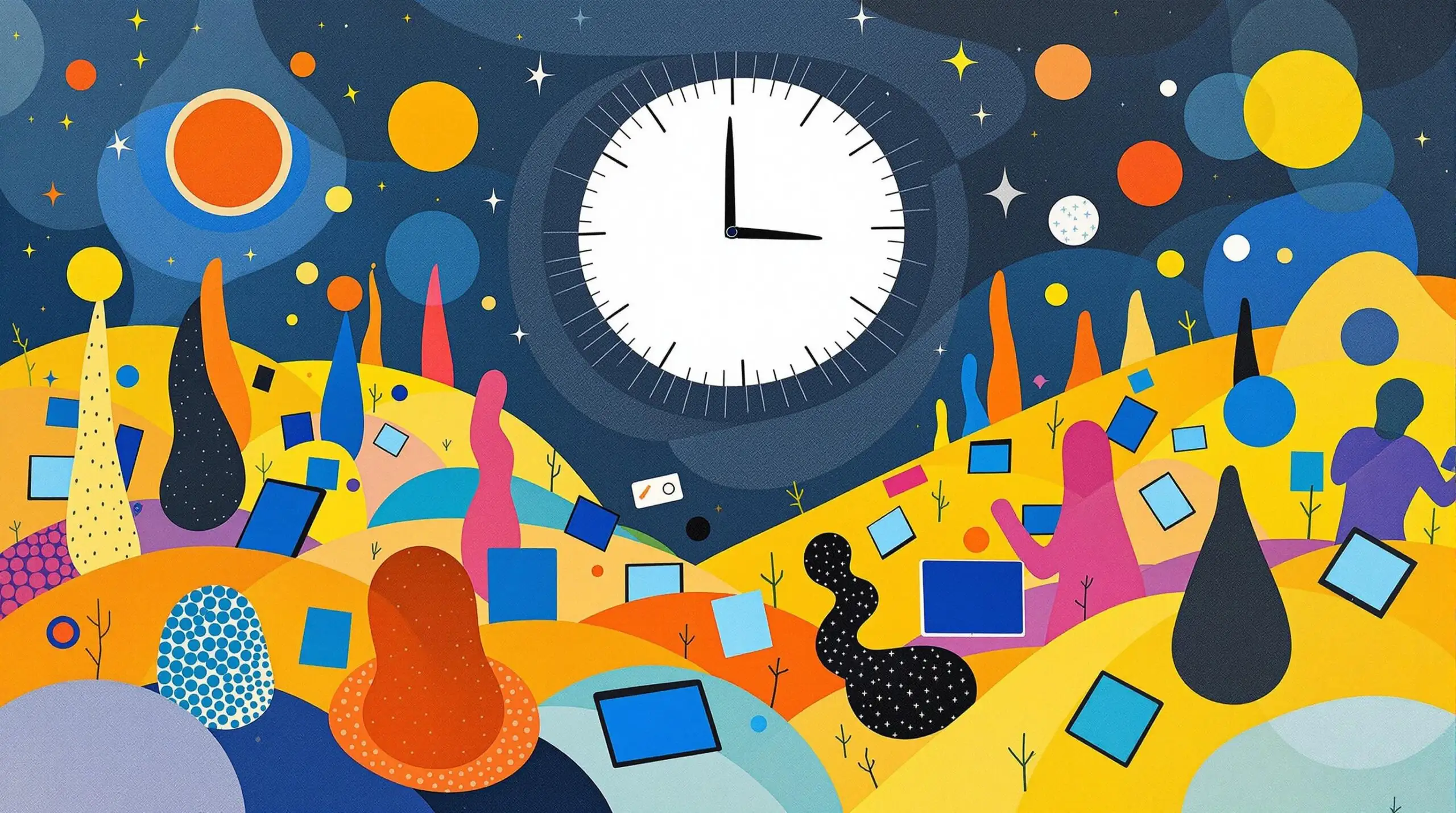Blue Light Blues: Screens, Sleep, and Accelerated Aging
Explore the impact of blue light from screens on sleep patterns and its potential role in accelerated aging.

Understanding Blue Light and Its Impact on Health
What is Blue Light and Why Should We Care?
Our modern lives are bathed in artificial light, particularly the blue wavelengths beaming from our screens. While sunlight contains blue light naturally, our increasing exposure to artificial sources through phones, tablets, and computers has created an unprecedented situation for human biology. The average American now spends over 7 hours daily staring at screens, with many logging considerably more during work hours.
The Science Behind Blue Light Exposure
Blue light sits on the high-energy end of the visible light spectrum, with wavelengths between 380 and 500 nanometers. Our bodies evolved to use these wavelengths as a natural timekeeper, helping regulate our circadian rhythm. The problem isn’t blue light itself – it’s the timing and intensity of our exposure. Evening screen time tricks our brains into thinking it’s still daytime, suppressing the production of melatonin, our sleep hormone.
Historical Context and Recent Developments
The widespread use of LED screens and energy-efficient lighting has dramatically increased our blue light exposure in the past two decades. Before artificial lighting, humans primarily received blue light from the sun during daylight hours. This natural pattern helped maintain healthy sleep-wake cycles. Today’s constant exposure has created what researchers call “circadian confusion” – a state where our internal biological clocks struggle to maintain proper timing.
Common Misconceptions About Blue Light
Many people believe blue light only affects sleep. In reality, its impact extends far beyond bedtime issues. While some marketing claims about blue light blocking glasses might be overblown, the fundamental effects of blue light on our biology are well-documented. Another myth is that all artificial light is equally disruptive – but blue wavelengths have a uniquely potent effect on our circadian rhythms.
Current Research and Statistics
Recent studies paint a concerning picture. Research shows that evening blue light exposure can suppress melatonin production by up to 85%. A 2021 study found that people who regularly use screens before bed take an average of 10 minutes longer to fall asleep and experience 30 minutes less total sleep time. These effects accumulate over time, potentially accelerating cellular aging processes.

The Connection Between Blue Light and Accelerated Aging
How Blue Light Affects Cellular Aging
Blue light exposure impacts our bodies at the cellular level. Research indicates that irregular light exposure patterns can disrupt DNA repair mechanisms that typically occur during sleep. This disruption may accelerate the aging process by allowing cellular damage to accumulate. Studies on skin cells have shown that blue light can generate reactive oxygen species, leading to inflammation and premature aging.
Poor sleep doesn’t just leave you tired – it fundamentally affects your lifespan. During proper sleep, our bodies perform crucial maintenance and repair functions. Disrupted sleep patterns linked to evening blue light exposure can reduce the efficiency of these processes. Research suggests that chronic sleep disruption may reduce life expectancy by up to 2-3 years.
Biological Mechanisms and Health Implications
Circadian Rhythm Disruption
Our circadian rhythm orchestrates countless biological processes. When blue light disrupts this internal clock, it affects everything from hormone production to cellular repair. The body’s natural timing system becomes confused, leading to cascading effects on metabolism, immune function, and cellular health.
Oxidative Stress and Inflammation
Excessive blue light exposure, especially during evening hours, can trigger oxidative stress in cells. This process damages cellular components and accelerates aging. Research has shown increased markers of inflammation in individuals with disrupted circadian rhythms, potentially contributing to age-related diseases.
Key Areas of Impact
Several biological systems show particular sensitivity to blue light exposure. The skin’s repair mechanisms work primarily at night, and disrupted sleep can impair this process. Metabolic function suffers from circadian disruption, potentially affecting weight management and insulin sensitivity. Brain health is also particularly vulnerable, as sleep plays a crucial role in clearing cellular waste products.
Practical Solutions for Minimizing Blue Light Impact
- Install blue light filtering software on all devices
- Use night mode settings after sunset
- Keep devices at least 12 inches from your face
- Take regular breaks using the 20-20-20 rule
- Stop screen use 2-3 hours before bedtime
- Invest in quality blue light blocking glasses
- Maximize natural daylight exposure during morning hours
- Replace bedroom lighting with amber or red options
- Create a device-free wind-down routine
- Regular eye examinations to monitor eye health
Technology Solutions and Innovations
Screen Technologies
Hardware manufacturers are developing new screen technologies that reduce blue light emission without compromising display quality. OLED screens typically emit less blue light than traditional LED displays. Some devices now include automatic color temperature adjustment based on time of day.
Software Solutions
Advanced software options now offer customizable blue light filtering. Apps can gradually adjust screen color temperature throughout the day, matching natural light patterns. Smart home systems can automatically adjust lighting to support healthy circadian rhythms.
Creating a Healthy Relationship with Technology
Daily Habits and Routines
Building healthy screen habits requires intentional changes. Setting specific times for device use, creating technology-free zones in your home, and establishing consistent sleep schedules all help minimize blue light’s negative effects. Morning sunlight exposure helps anchor your circadian rhythm, making you more resilient to evening light exposure.
Workplace Considerations
For those who must use screens extensively for work, proper setup becomes crucial. Positioning screens to reduce glare, maintaining proper viewing distances, and taking regular breaks can significantly reduce the impact of blue light exposure. Some companies now offer circadian-friendly lighting systems in their offices.
Future Implications and Research Directions
Scientists are investigating new ways to mitigate blue light’s effects on aging. Promising research areas include protective compounds that could shield cells from light-induced damage, and more sophisticated light-filtering technologies. Understanding the genetic factors that influence individual sensitivity to blue light could lead to personalized protection strategies.
The relationship between blue light exposure and accelerated aging presents a modern health challenge requiring immediate attention. While technology brings numerous benefits, we must balance these against potential health impacts. By implementing practical strategies to manage blue light exposure, we can maintain the benefits of modern technology while protecting our long-term health and longevity. The key lies in creating sustainable habits that work with our biology rather than against it.